in Japanese, is a packed meal that is commonly eaten as lunch in Japan. Many school children and workers take a single-portion, homemade meal packed in a bento box to school or to the office every day. Bento is also a popular take-out food, sold pretty much everywhere you go in Japan, from convenience stores and train stations to high-end department store delis. Many traditional restaurants serve bento only during lunchtimeoften in a wood or lacquered bento boxor you can sample beautifully prepared dishes from an elaborate multicourse meal in one simple box at a much lower price. Bento culture has such a long and diverse history in Japan that it is hard to define exactly why people eat bento. The oldest records show that people were already eating portable, dried rice as early as the fifth century.
When the tea ceremony culture developed, elaborate lacquer wares, which held foodsimilar to todays bento boxesstarted to appear. By the 1600s, the upper class were bringing along these lacquer wares so they could eat while enjoying cherry-blossom viewing parties. Ever since then, bento has been a part of Japanese culture. People ate makunouchi bento, an upscale mixed bento, at the intermissions of plays in the Edo period (16031867). Lower-ranked samurai, who made less money, brought their own bento lunches to work to save money, just like Japanese salary men today. In the late nineteenth century, when people started traveling by train, ekiben, the bento sold at train stations (eki), started to become popular.
There are hundreds of ekiben all over the country today for people traveling on the many trains in Japan.
BENTO FOR EVERYONE
Bento has become so popular that if there is a demand from anybody, there is a kind of bento available. The hot bento chain stores started to spread throughout the country during the 1980s, and people ate those freshly made bentos as meals at home for dinner, not just for lunch. Convenience stores began to carry varieties of reasonably priced bento, and they became popular among students and young singles who did not want to cook.
Depachika, the underground gourmet food floor found in department stores, attracted housewives for fancy bento to bring home, to have a break from daily cooking.
Kyaraben, or character bento, incorporates cute characters from animation or other pop culture into the bento food.
For example, a mother might make the face of a childs favorite TV character by carefully arranging rice and vegetables. They first became popular among mothers of small children, and it has continued to inspire people on social media. Today kyaraben is a big industry, selling all kinds of tools and products for making these cute and amusing bento. Many people, however, use bento for pragmatic reasons, such as people who bring their own lunches to school or work, where food is not readily available; even people who have access to cafeterias and restaurants make and bring bento. The reasons may varywhether its economic, convenience, health or safety, or simply that they prefer bento meals. In recent years, bento has become increasingly popular outside of Japan.
We have started to see more food establishments serving bento, and there are more blogs, articles, and books about bento, many of them are written in English. Many bento enthusiasts around the world proudly post their neatly prepared bento photos on social media, and you can buy all kinds of bento boxes, accessories, and tools from online stores. The trending bentos are not necessarily the traditional Japanese versions, and range from quick and easy food to elaborate kyaraben.
THE BENEFITS OF BENTO
What motivates us to make bento is that it enables us to make safe and healthy lunches for our families. Like most parents, we dont eat the same way we did when we were young and single. Watching what we put into our bodiesespecially when feeding young childrenseems more important than ever before.
We want to feed our families with safe meals. We want to make sure they have enough nutrition. We know what is in the food. Beyond the food itself, we want to save money for our families futures, to put away more for college and retirement funds, by not eating out all the time. But we are also busy with work and chores, and, yes, tired and lazy some days too! Bento makes it easy to get our kids the nutrition they need without using half the day to do it. We have become used to planning for bento as part of our everyday cooking.
While making dinner, for example, we always make extra so there is enough for the next days lunch, or we add a few extra steps, such as blanching and cutting vegetables the night before for a bento lunch the next day. Well share these tips and tricks throughout the book with you. Not sure if you can successfully incorporate bento into your busy life? We have an ultimate form of bento in Japan called osechi, which is the New Year feast. Osechi consists of layered boxes filled with many small dishes, and there are many tedious steps for making each dish. The work of making all the osechi dishes is so overwhelming that these days, more people are buying this feast rather than preparing it themselves. So how do you preserve a rich tradition such as osechi without the hours of tedious steps? The secret is that you really dont have to make it perfectly.
We once read in a cooking magazine that you can learn to make osechi by preparing only one homemade dish and then buying the rest of the dishes elsewhere. That same idea can apply for daily bento-making too. If a bento recipe seems like too much work, start with one of our . Eventually, youll feel comfortable enough to try two side dishes, and soon youll be making complete bento meals in no time. Then one day, perhaps, youll be skilled enough to prepare an osechi on your own!
THE STORY BEHIND JAPANESE COOKING 101
We met at our kids preschool over ten years ago. While the kids were playing on the playground, we introduced ourselves and began to talk.
We discovered that we were both originally from the Kansai region of Japan; Noriko grew up in Osaka, and Yuko in nearby Kyoto. We moved to America in the early nineties and studied here. Noriko became a pastry chef while Yuko worked in software in Silicon Valley. We talked about kids, we talked about school, but mostly we talked about food. We are both avid home cooks and make Japanese food, American food, sweets, and, of course, bento at home. We realized that so many Americans liked Japanese food but found it intimidating to cook at home.
We knew everyone could do it with some help, and so when our kids became older and we had a little more time to ourselves, we decided to make videos on how to make Japanese food at home with ease. This is how our website, Japanese Cooking 101 (japanesecooking101.com), was born. On the site, we try to show simpler ways of making your favorite Japanese foods with easy-to-find ingredients. We also introduce authentic dishes that Japanese families eat in their homes (besides sushi and tempura), so you can add a few new, delicious favorites to your dinner selections. But we had another big ambition when we started our website: we wanted to pass the Japanese food culture on to our children. Our kids were born in America, and being second generation, they have not yet fully appreciated the wealth of their Japanese background.



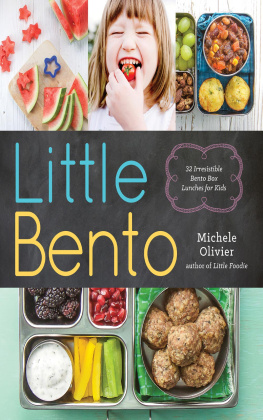

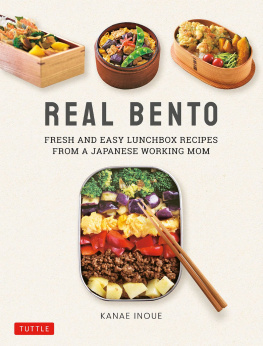


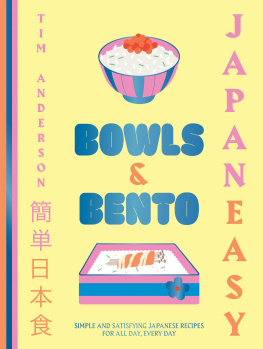



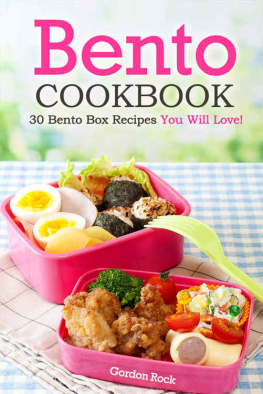
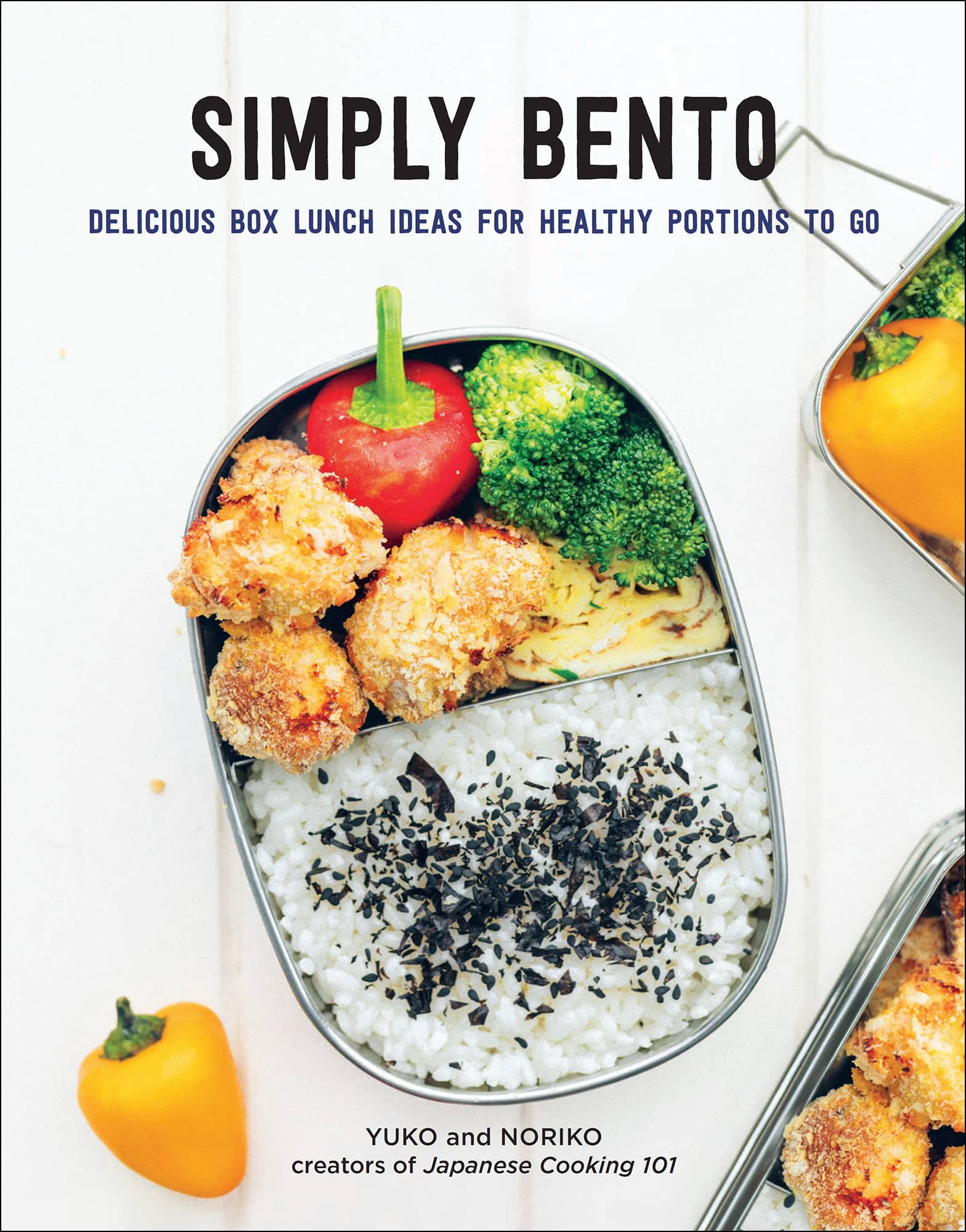



 in Japanese, is a packed meal that is commonly eaten as lunch in Japan. Many school children and workers take a single-portion, homemade meal packed in a bento box to school or to the office every day. Bento is also a popular take-out food, sold pretty much everywhere you go in Japan, from convenience stores and train stations to high-end department store delis. Many traditional restaurants serve bento only during lunchtimeoften in a wood or lacquered bento boxor you can sample beautifully prepared dishes from an elaborate multicourse meal in one simple box at a much lower price. Bento culture has such a long and diverse history in Japan that it is hard to define exactly why people eat bento. The oldest records show that people were already eating portable, dried rice as early as the fifth century.
in Japanese, is a packed meal that is commonly eaten as lunch in Japan. Many school children and workers take a single-portion, homemade meal packed in a bento box to school or to the office every day. Bento is also a popular take-out food, sold pretty much everywhere you go in Japan, from convenience stores and train stations to high-end department store delis. Many traditional restaurants serve bento only during lunchtimeoften in a wood or lacquered bento boxor you can sample beautifully prepared dishes from an elaborate multicourse meal in one simple box at a much lower price. Bento culture has such a long and diverse history in Japan that it is hard to define exactly why people eat bento. The oldest records show that people were already eating portable, dried rice as early as the fifth century.